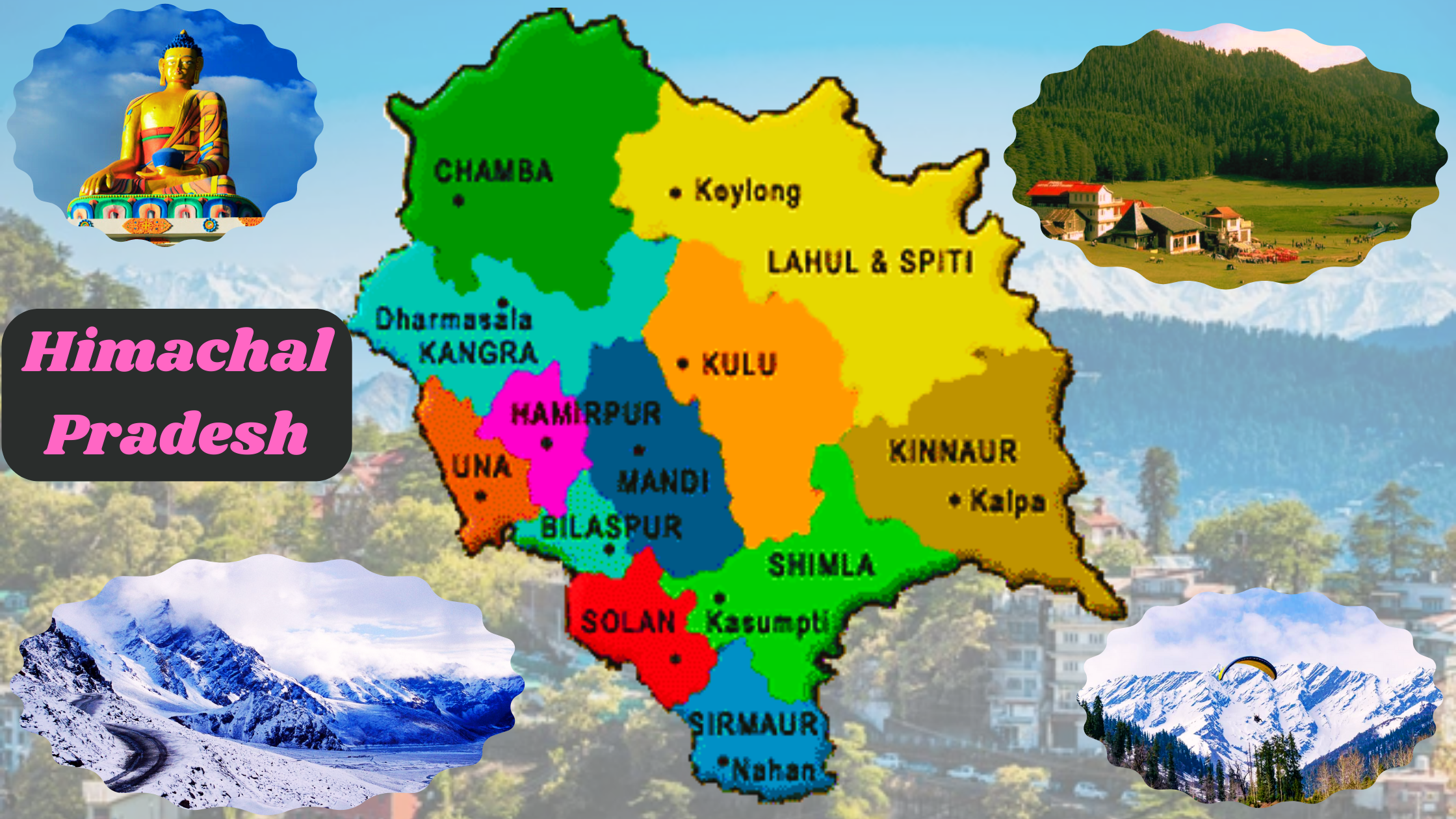Himachal Manali
Himachal Pradesh is located in the north region of India. Himachal Pradesh, located in the Western Himalayas is one of India’s thirteen mountain states. Its dramatic landscape includes tall peaks and deep valleys. The state of Himachal Pradesh is located in northern India. It shares its borders with Jammu and Kashmir, Ladakh, Haryana, Uttarakhand, Uttar Pradesh, and Uttarakhand. Himachal Pradesh also shares a small border with the Tibet Autonomous Region in China. The state is also known as Dev Bhoomi which means ” Land of Gods” and Vener Bhoomi which means ” Land of the Brave“.
Himachal Pradesh is a region that has been inhabited for thousands of years. Its rich history was shaped by multiple waves of migration. The area has been ruled over the centuries by several local kingdoms. Some of these acknowledged the suzerainty larger empires. Himachal Pradesh, which was a part of British India’s Punjab Province before India gained independence from British colonial control, was a province in British India. After independence, the region began as the chief commissioner’s province and later became a Union Territory. 1966 saw the merging of hilly Punjab with Himachal Pradesh. January 25, 1970, was when the state received its full status.
Himachal Pradesh’s landscape is characterized by its perennial river and its picturesque valleys. Agriculture is the main driver of the state’s economy. Horticulture Hydropower and Tourism follow closely behind.
Himachal Pradesh: A Natural Beauty, and Economic Prosperity
The fertile soil of the state is home to a wide variety of crops. apples are a popular horticultural crop. In addition, the state has a number of hydropower plants which harnesses the energy from its river systems.
This contributes significantly to India’s production of renewable energy. Himachal Pradesh has one of India’s most electrified infrastructures, with 99.5% households having electricity by 2016… Himachal Pradesh has also been declared India’s second free of open defecation state by 2016, This is a reflection of its commitment to improve sanitation, and health. In the 2017 CMS India Study, the state ranked second in the country for the least corrupt.
The state is divided administratively into twelve districts. These districts are the units of local governance and development. Shimla is the state’s Summer Capital, and Dharamshala is the Winter Capital.
The name Himachal is closely linked to the cultural and geographical identity of the state. The word Himachal comes from two Sanskrit terms: hima meaning “snow” and acala meaning “mountain or home”. The term Himachal translates to ” snowy province ” or ” land nestled in the Himalayas.” After India’s Independence, Diwakar Dash Sharma first used the term. It is believed to have been inspired from the Hindi national anthem Jangan Man.
Historially, ” Himachal ” was used to indicate the region’s position in the Himalayas. It was seen as the land protected by mountains and snow. The geographic feature is important to the identity and lifestyle of the state. After India’s Independence, the division into Punjab Province resulted in the adoption of the official name Himachal Pradesh.
A rich and diverse history of Himachal Pradesh
Himachal Pradesh is a state with a long and varied history. It spans many millennia. The Indus Valley civilization, which thrived between 2250-1750 BCE, was the first to have left evidence of its presence in the region. Kols, Mundas, and Bhotas are thought to be the first tribes in the hills of the state.
The region was once home to a number of small republics known as Janapadas. These were eventually conquered and absorbed by the Gupta Empire. After a short period of rule by king Harshavardhana the region was fragmented and frequently invaded by Delhi Sultanate. Mahmud ghaznavi conquered Kangra in the beginning of the 11th century. Timur, Sikander lodi, and Kangra fort were the main targets of subsequent invasions. In time, the Mughal empire was acknowledged by the Rajput Kingdoms of the region. They paid regular tributes to the Mughal Empire.
Under the leadership of Amar Singh Thapa, the Gorkha Kingdom began expanding its territories in Nepal during 1768. They occupied several areas, including Sirmour, Shimla and Kangra. In 1806, the Gorkhas defeated Sansar chand Katoch. Kangra Fortress remained beyond their grasp until Maharaja Ranjit Singh took control in 1809. After their defeat, they shifted their attention southwards, where they fought with the British along the Tarai belt. The British forced them out of the region, and they began consolidating their power. British Influence in Himachal Pradesh grew.
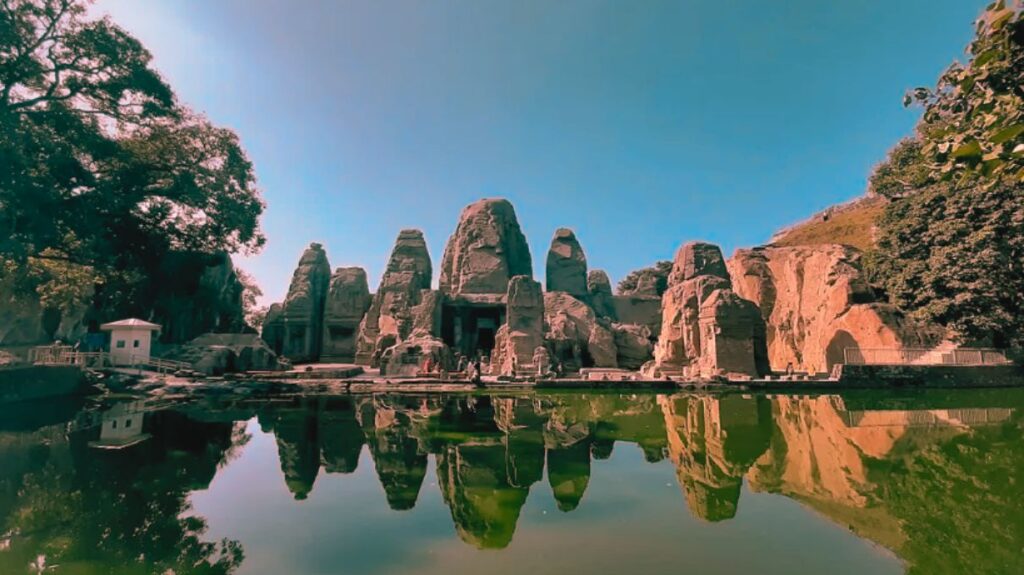
The hill states of Himachal Pradesh were not as active as the rest of India during the First War of Indian Independence 1857. This war is also known as Sepoy Mutiny. Chamba rulers, Bilaspur rulers, Bhagal and Dhami rulers even assisted the British forces in the revolt. As the British Crown took direct control of India in 1858, Himachal Pradesh states like Chamba and Mandi began to make significant progress in areas such as education, infrastructure and healthcare.
World War I was a time when the rulers of hill states showed their loyalty by contributing to the British war effort with manpower, and resource. States like Kangra Chamba Mandi and Bilaspur took part.
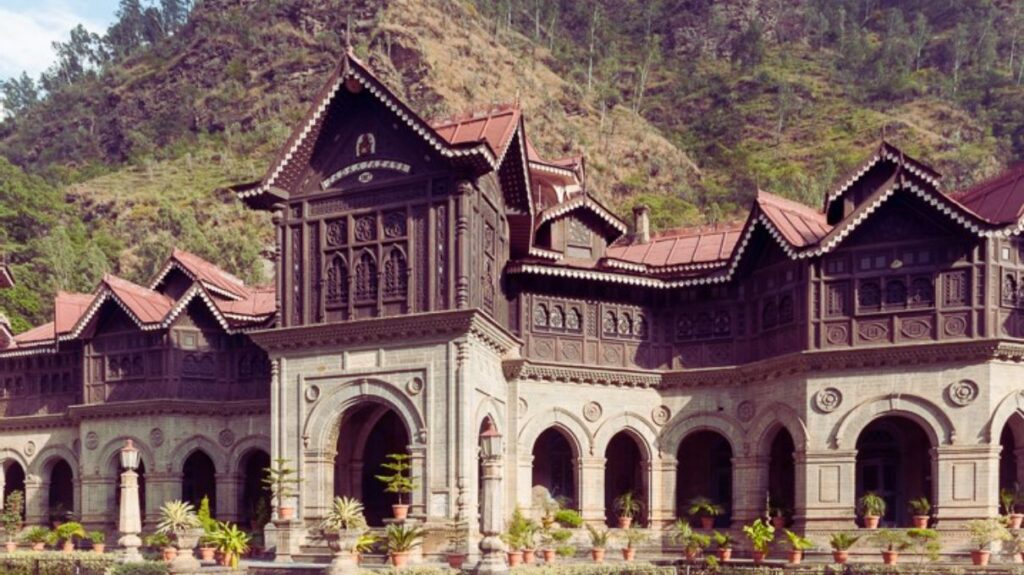
After India’s Independence in 47 the region underwent a political integration process. After the amalgamation of thirty princely states located in western Himalayas, the Chief commissioner’s province of Himachal Pradesh formed on 15 April 1948. The integration continued after the merging of Bilaspur and 1st July 1954. Himachal Pradesh began as a part ‘C” state, under the Indian Constitution. It was given a Governor and a Legislative Assembly in 1952.
Himachal Pradesh was made a Union Territory on November 1, 1956. In 1966, as part of the Punjab Reorganisation Act (PRA), areas of Punjab, including Simla, Kangra and Kullu Districts, Lahul, Spiti Districts and parts of PEPSU, were merged with Himachal Pradesh. The State Of Himachal Pradesh Act passed the Indian parliament on 18 Dec 1970. The state was created on January 25, 1971.
Himachal Pradesh was the 18th state in India. Yashwant Parmar became its first chief minister. It was the official establishment of Himachal Pradesh as a modern state.
Geography of Himachal Pradesh
Himachal Pradesh lies within the western Himalayas between 30deg22’N and 33deg12’N and 79deg04’E and 75deg47’E, covering 55673 square kilometers (21,4995 sq mi). Known for its mountainous landscape, Himachal Pradesh covers 55673 square kilometers (21.495 sq mi). The Great Himalayan Range dominates eastern and northern parts of Himachal Pradesh while Dhauladhar Range, Pir Panjal Ranges and Shiwalik Ranges make up its main features; Reo Purgyil stands tallest at 6,816 metres!
Himachal Pradesh boasts an expansive and complex drainage system consisting of glaciers and rivers. As one of the primary water sources for both the Indus and Ganges basins, rivers such as Chandra Bhaga, Ravi, Beas and Sutlej also cross its territory and receive their source from snowmelt as well as rainfall. Three out of four Punjab rivers originated here – Satluj Valley Spiti Valley Beas Valley being three; Chenab River flows through Lahaul Pangi Chamba while Giri and Pabbar are part of Yamuna Basin.

Himachal Pradesh’s varied elevation creates diverse climate conditions. Southern mountain ranges experience humid and hot subtropical weather conditions while northern and east mountain ranges boast cold alpine climates. Dharamsala is home to heavy rainfall while Spiti and Lahaul remain relatively arid regions. Himachal Pradesh experiences three distinct seasons: Summer, Winter and Rainy Season with average summer temperatures between 28-32/degC (82-90degF). Winter temperatures often dip significantly lower – snowfall is widespread – while Himachal Pradesh was India’s inaugural non-smoking state as a result of efforts taken against traditional methods of cooking that pollutant air pollutants.
Flora and Fauna Himachal Pradesh forms part of the Indian Himalayan Region – one of the richest hotspots for biological diversity worldwide. Within this area are rare medicinal species as well as rarer wild varieties, making this state rich with botanical resources that threaten herbal resources worldwide. According to Forest Survey of India estimates 66.52 percent of Himachal Pradesh is covered by forests.
Himachal is home to a wide range of plant life, which varies based on elevation and rainfall. Lahaul Spiti region supports unique medicinal plants like Ferula Jaeschkeana and Hyoscyamus Niger while Himachal, known as “the Fruit Bowl of India”, boasts apple, peach and cherry orchards as well as hillsides with wildflowers such as gladiolas carnations roses and tulips that attract tourists.
Himachal Pradesh boasts a rich diversity of wildlife. The state bird, Western Tragopan, is one of the rarest birds on earth and one of 77 different mammals found here including Snow Leopards and 44 reptile and eight fish species; Pin Valley National Park being one of these while Great Himalayan National Park being designated a UNESCO World Heritage Site are just a couple more national parks within Himachal. Additionally, there are thirty wildlife sanctuaries and three conservation reserves within its boundaries as well.
Himachal Pradesh follows a system of parliamentary government, similar to other Indian states. Following Independence, the state was created from 30 princely States unified together under one administration. In 1952, its Legislative Assembly was created, later becoming a Union Territory. Today its unicameral legislature comprises of 68 members who each serve 5-year terms until dissolving earlier.
The Indian President appoints a Governor as titular head of state. The Chairman of the Legislative Assembly who also leads or represents a coalition majority has executive authority; The Council of Ministers under Chief Minister serves as advisors and advises both Governor and Legislative Assembly; Finally local government functions are carried out through Panchayat elections for local bodies.
Indian National Congress (INC), winning 40 of 68 Assembly seats in 2022, was followed by Bharatiya Janata Party with 26 Assembly seats won. Sukhvinder Singh Sukhu became Himachal Pradesh’s 15th Chief Minister on 11 December 2022 while Mukesh S Agnihotri served as his deputy.
Administrative Divisions
Administrative Divisions of Himachal Pradesh
Himachal Pradesh is organized into 12 districts, which are grouped into three administrative divisions: Kangra, Mandi, and Shimla. This division aids in the efficient governance and administration of the state. The districts are as follows:
Kangra Division:
- Chamba
- Kangra
- Una
Mandi Division:
- Bilaspur
- Hamirpur
- Kullu
- Lahaul and Spiti
- Mandi
Shimla Division:
- Kinnaur
- Shimla
- Sirmaur
- Solan
The state also has a comprehensive administrative structure, consisting of 73 subdivisions, 78 blocks, and 172 tehsils. Himachal Pradesh’s local governance framework includes 54 urban local bodies and 59 towns. The rural areas are further divided into 3,615-gram panchayats and 20,690 villages, providing a decentralized system of governance.
In terms of law enforcement, the state has 130 police stations. The legislative structure includes 4 Lok Sabha seats and 3 Rajya Sabha seats. The state assembly is made up of 68 constituencies, ensuring representation across its diverse population.
Economy of Himachal Pradesh
Himachal Pradesh has made significant strides in economic growth, with its Gross State Domestic Product (GSDP) reaching ₹172,174 crore in 2021. The state ranks as the 22nd-largest economy in India and has one of the highest per capita incomes in the country, at ₹160,000.

Agriculture
Agriculture is the backbone of Himachal Pradesh’s economy, contributing 9.4% to the state’s net domestic product. With nearly 90% of the population directly involved in agricultural activities, the sector remains a primary source of livelihood. About 62% of the workforce is engaged in farming, with traditional farming methods such as terrace farming widely practiced.
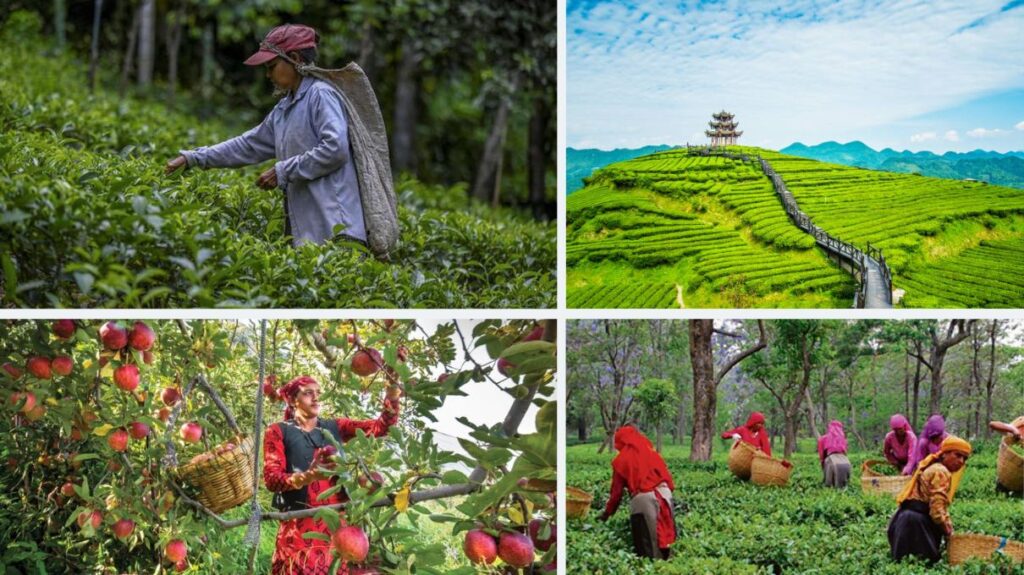
The major crops grown in Himachal Pradesh include wheat, maize, barley, rice, and pulses. The state’s diverse topography allows for the cultivation of a variety of crops, although the primary agricultural output is fruit, particularly apples.
Fruit Cultivation and Horticulture
Himachal Pradesh is known for its extensive fruit orchards, especially apples. It is the second-largest apple-producing state in India, contributing significantly to the national economy. Apples are the state’s principal cash crop, and the economic benefits from apple cultivation support thousands of farmers. Other fruits cultivated in the state include apricots, peaches, cherries, and pears.
The state’s apple-growing regions, including the Kullu, Shimla, and Kangra valleys, are globally renowned for producing high-quality apples. The state’s unique climate and geography create ideal conditions for horticulture, making it a key sector in Himachal Pradesh’s agricultural economy.
Tea Production
The Kangra Valley has a long history of tea production, and the tea grown here is known for its distinct flavor. Kangra tea has received Geographical Indication (GI) status, which acknowledges its unique qualities. The region’s tea gardens produce high-quality leaves, which are sold domestically and internationally.
Pharmaceutical Industry
Himachal Pradesh has earned the title of Asia’s pharmaceutical hub, with 652 pharmaceutical units operating within the state. The pharmaceutical industry is valued at ₹40,000 crore, making it a key pillar of the state’s economy. The region is home to several large and small-scale pharmaceutical companies, which manufacture a wide range of medicines, contributing to both the local and national markets.

Hydroelectric Power
One of the most significant assets of Himachal Pradesh is its abundant hydropower potential. Due to its mountainous terrain and numerous perennial rivers, the state is a major producer of hydroelectric power. The state has a vast capacity for hydropower generation, estimated at 27,436 MW. Currently, the state has a generation capacity of 10,351 MW, and much of this surplus energy is exported to neighboring states such as Delhi, Punjab, and West Bengal.
The revenue from hydropower exports helps subsidize the electricity rates for local consumers, making electricity both affordable and accessible. Approximately 94.8% of households in Himachal Pradesh have access to electricity, a significant achievement in rural electrification.
Industrial Development
In addition to the pharmaceutical industry, Himachal Pradesh has developed a diverse industrial base that includes manufacturing, food processing, and information technology (IT) services. The state has established industrial zones in cities like Baddi and Parwanoo, attracting both national and international companies.
Agriculture and Horticulture Initiatives
Agriculture remains a major source of income and employment in Himachal Pradesh, with the state focusing on the development and modernization of agricultural practices. Traditional irrigation systems, such as the Kuhl system in the Kangra Valley, are central to the farming community’s success. However, these systems are increasingly threatened by modern hydro projects and environmental challenges.
In response, the state has introduced various agricultural development programs to support sustainable farming and enhance productivity. One such initiative is the Mid-Himalayan Watershed Development Project, which aims to improve agricultural productivity, raise rural incomes, and ensure environmental sustainability.
Through these efforts, the state has been able to protect its environment while encouraging agricultural growth. Organic farming and water conservation techniques are also being promoted as part of the ongoing agricultural reforms to protect the state’s unique farming traditions.
Tourism in Himachal Pradesh
Tourism is one of the key drivers of Himachal Pradesh’s economy, contributing significantly to both its local livelihood and cultural heritage. The state’s diverse landscape, ranging from snow-capped mountains to lush valleys, and its rich cultural and religious traditions, make it a prime tourist destination. Known as the “Land of Gods,” Himachal Pradesh offers a unique blend of spiritual experiences, adventure sports, and scenic beauty, making it a popular destination for both domestic and international visitors.
Popular Hill Stations and Destinations
The state’s magnificent Himalayan setting attracts tourists looking for peace, adventure, and natural beauty. Some of the most renowned hill stations and travel destinations in Himachal Pradesh include:
- Shimla: As the state capital, Shimla is famous for its colonial architecture, pleasant weather, and scenic views. The town also hosts Asia’s only natural ice-skating rink, making it a year-round attraction for visitors.
- Manali: Known for its breathtaking beauty and adventure activities, Manali is a hotspot for tourists. Activities like skiing, paragliding, trekking, and river rafting make it a favorite for adventure enthusiasts.
- Dharamshala: Home to the Dalai Lama, Dharamshala is a hub for Tibetan culture and Buddhism. Its peaceful surroundings and spiritual significance attract both tourists and pilgrims alike.
- Dalhousie: A quaint hill station with stunning colonial buildings, Dalhousie offers panoramic views of the Himalayas and a serene atmosphere, perfect for those seeking solitude.
- Kullu: Famous for its lush valleys, ancient temples, and adventure sports like rafting and paragliding, Kullu is another sought-after destination for outdoor lovers.
- Chamba: Known for its temples, ancient monuments, and tranquil landscapes, Chamba is a historically rich town that offers a glimpse into Himachal’s cultural heritage.
- Khajjiar: Often referred to as the “Mini Switzerland of India,” Khajjiar is a picturesque location known for its lush meadows, forests, and pristine lakes, making it a perfect spot for nature lovers and photographers.
- Kasauli: A quiet hill town with colonial-era charm, Kasauli offers scenic walks and panoramic views of the surrounding mountains, making it ideal for a peaceful getaway.
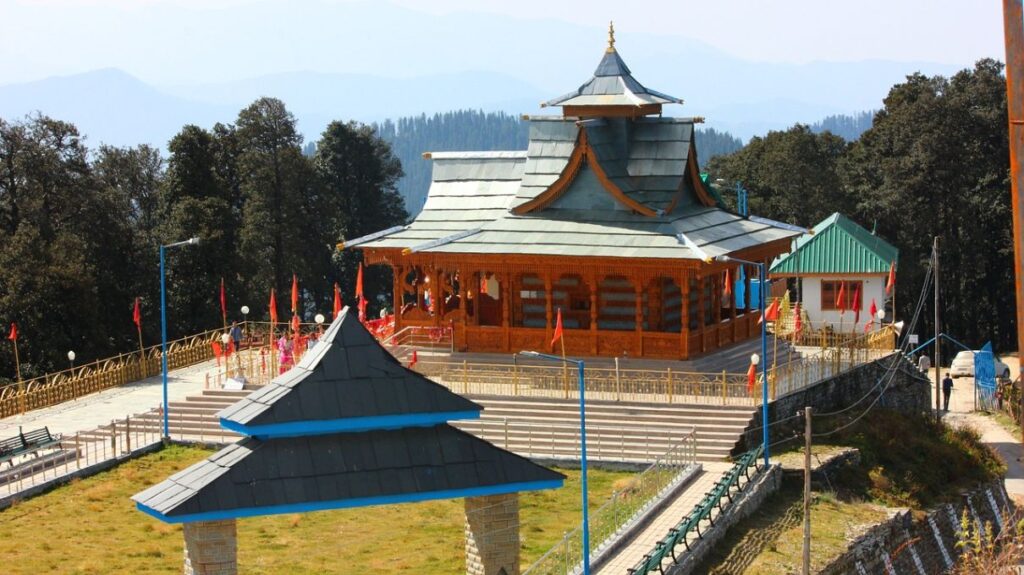
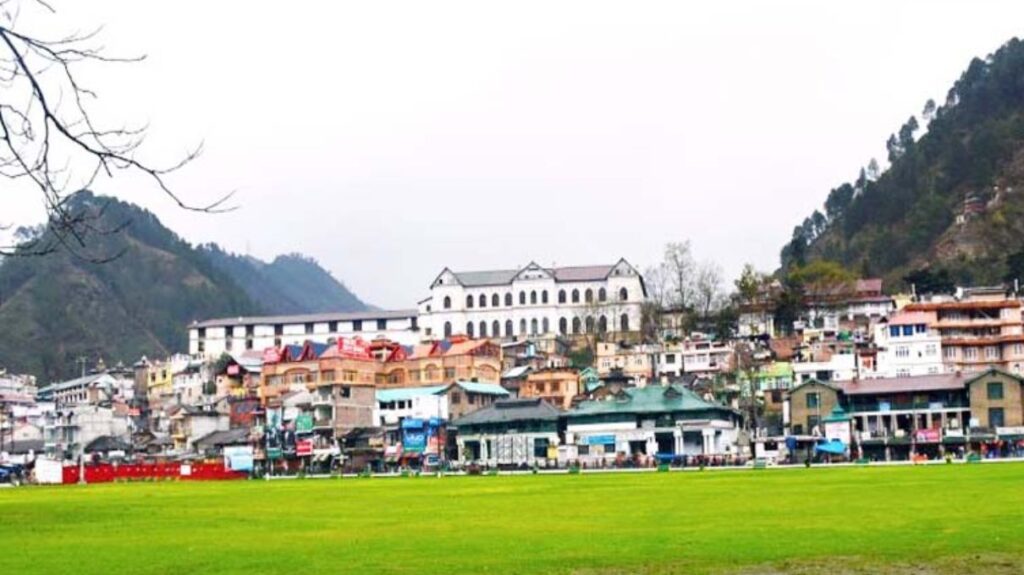
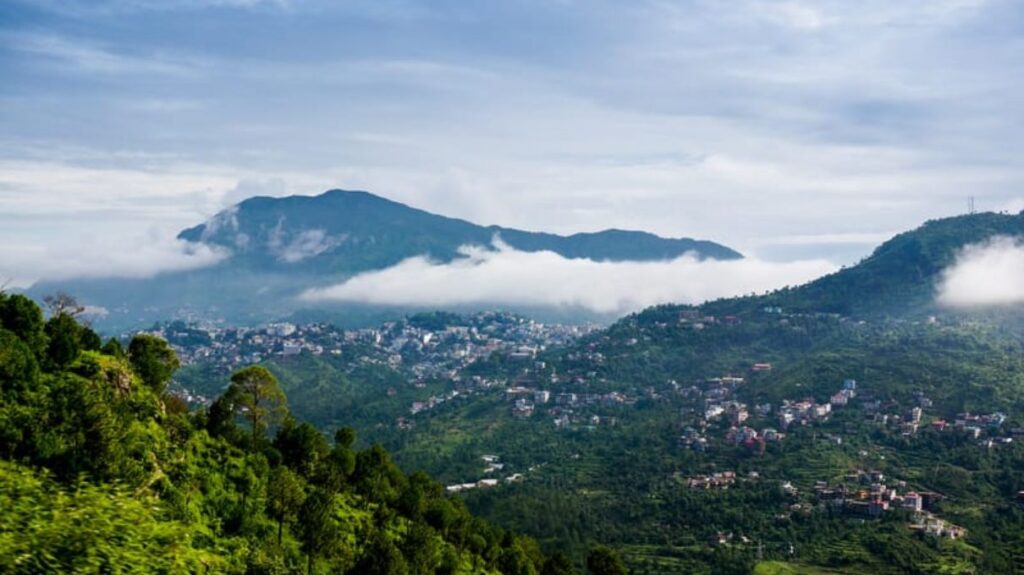

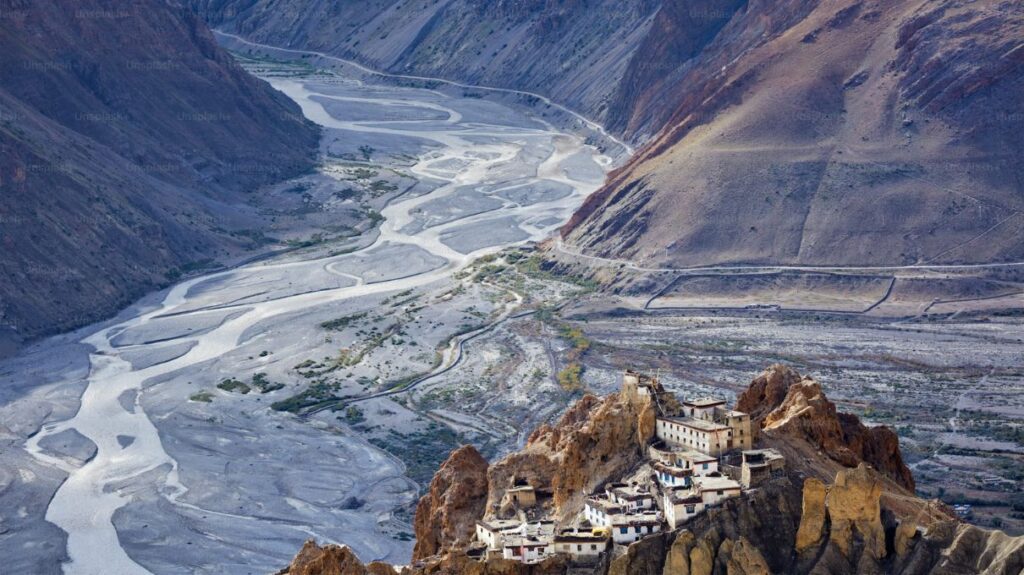

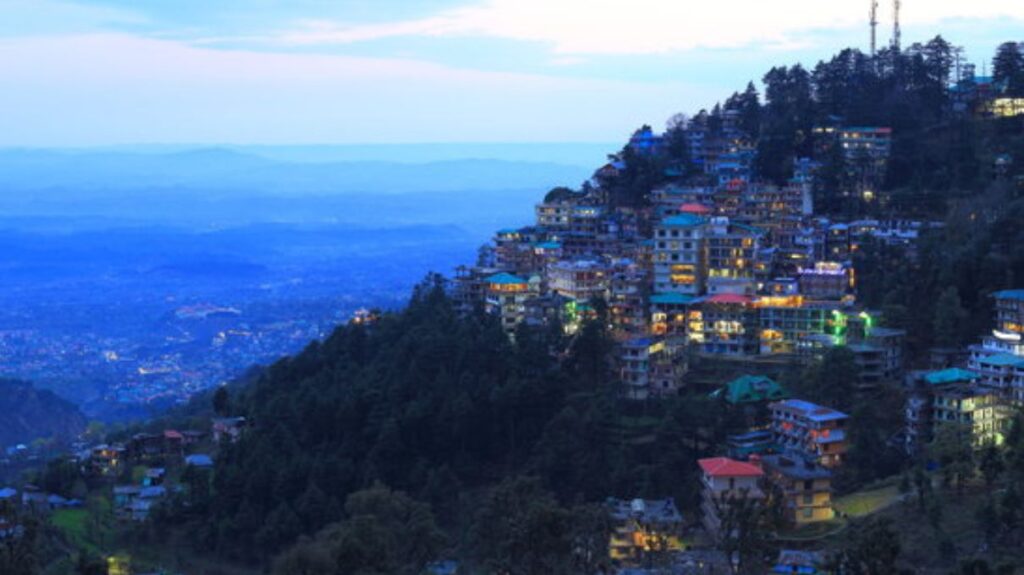

Pilgrimage Tourism
Himachal Pradesh, known as “Dev Bhoomi” (Land of Gods), is home to numerous temples and pilgrimage sites that attract millions of devotees each year. Some of the prominent temples and sacred sites include:
- Shri Chamunda Devi Mandir: A highly revered temple dedicated to Goddess Chamunda, located on the banks of the Banganga River.
- Naina Devi Temple: A famous Hindu temple located in Bilaspur, dedicated to Goddess Naina Devi.
- Bajreshwari Mata Temple: Situated in Kangra, this ancient temple is dedicated to Goddess Bajreshwari, one of the Shakti Peethas in India.
- Jwala Ji Temple: Known for its eternal flame, Jwala Ji is a unique temple dedicated to the goddess of fire.
- Chintpurni Temple: A highly visited temple in Una dedicated to Goddess Chintpurni, believed to fulfill devotees’ wishes.
- Baijnath Temple: A temple dedicated to Lord Shiva, located in the picturesque Baijnath town of Kangra.
- Bhimakali Temple: A stunning temple in Sarahan, dedicated to Goddess Bhimakali, featuring a blend of Hindu and Buddhist architecture.
- Jakhoo Temple: Located in Shimla, this ancient temple dedicated to Lord Hanuman offers stunning views of the surrounding area.
A significant pilgrimage trek is the Manimahesh Lake Trek, held annually in August in the Chamba district. Thousands of devotees’ trek to this holy lake, which is surrounded by mountains and considered sacred.

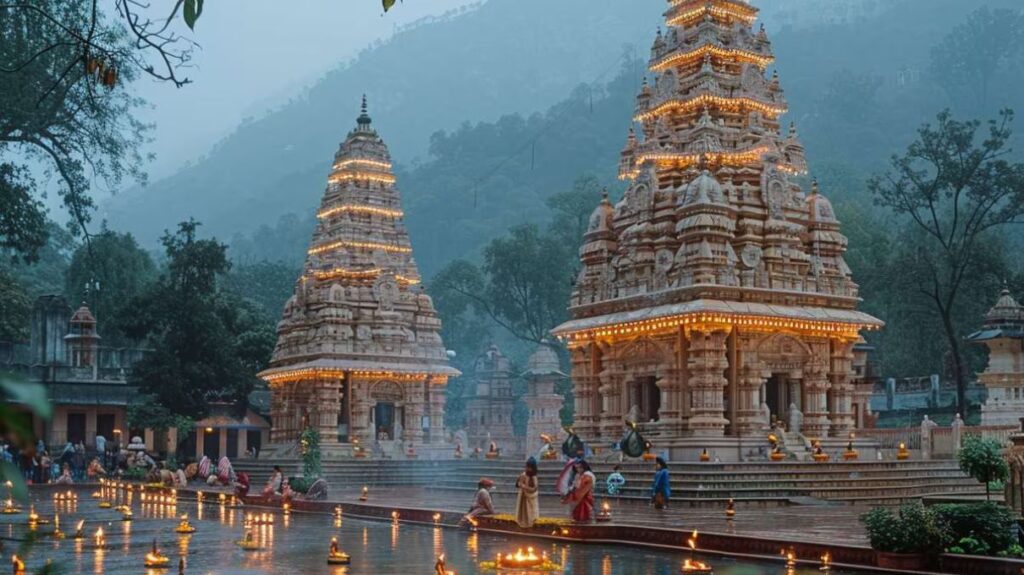
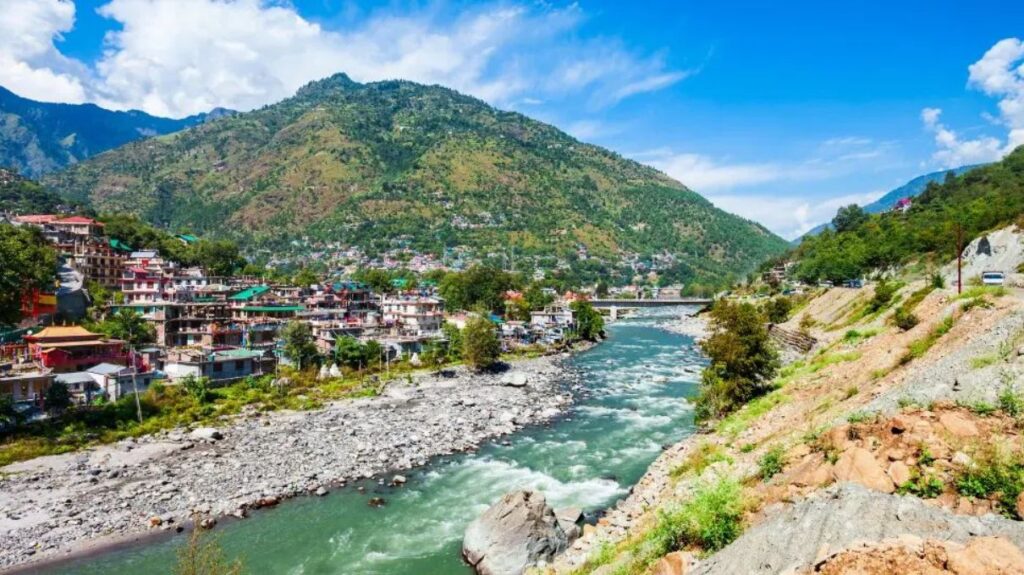
Adventure Tourism
Himachal Pradesh is a paradise for adventure lovers, offering a wide range of activities set against its rugged and diverse landscape. Some of the most popular adventure sports in the state include:
- Ice Skating: Shimla’s natural ice-skating rink is one of the most famous spots in Asia for this winter sport, attracting tourists during the winter months.
- Paragliding: The Bir Billing region in Kangra is considered one of the best places in the world for paragliding, hosting the Paragliding World Cup in 2015.
- Rafting: The Parvati River near Kasol and the Beas River in Kullu offer excellent white-water rafting experiences for thrill-seekers.
- Skiing: Manali’s Solang Valley is one of India’s most popular skiing destinations, drawing visitors for both winter sports and breathtaking views.
- Trekking: Himachal Pradesh offers numerous trekking routes. Some of the best trekking destinations include:
- Triund: A moderate trek with panoramic views of the Dhauladhar mountain range.
- Spiti Valley: A rugged and remote region known for its stunning landscapes, ancient monasteries, and unique culture.
- Kullu Valley: A haven for trekkers with a variety of trails suited for all levels of experience.
- Mountain Biking: With its diverse terrain, Himachal Pradesh is perfect for mountain biking, particularly around Manali and Spiti Valley, where the rugged tracks and scenic landscapes provide an exhilarating experience.



Cultural and Religious Festivals
Himachal Pradesh’s festivals are vibrant celebrations that reflect the state’s rich cultural and religious heritage. Some of the prominent festivals include:
- Kullu Dussehra: A week-long festival in Kullu, where deities are carried in grand processions, accompanied by traditional performances.
- Chamba’s Minjar: A harvest festival celebrated in Chamba with colorful processions, music, and folk dances.
- Renuka Ji Fair: A religious fair held in honor of Goddess Renuka, celebrated with rituals, fairs, and cultural events.
- Lohri: A festival that marks the end of winter, celebrated with bonfires, traditional folk dances, and songs.
- Mandi Shivratri: A major religious festival celebrated in Mandi with a procession of deities from various parts of the region.
- Phagli: A local festival celebrated in villages with folk dances, music, and festivities to mark the end of winter.
- Losar: The Tibetan New Year, celebrated with rituals, ceremonies, and cultural performances in Tibetan communities across the state.
- Halda: A festival celebrated in the tribal areas of Himachal Pradesh, where communities honor their local traditions and deities.
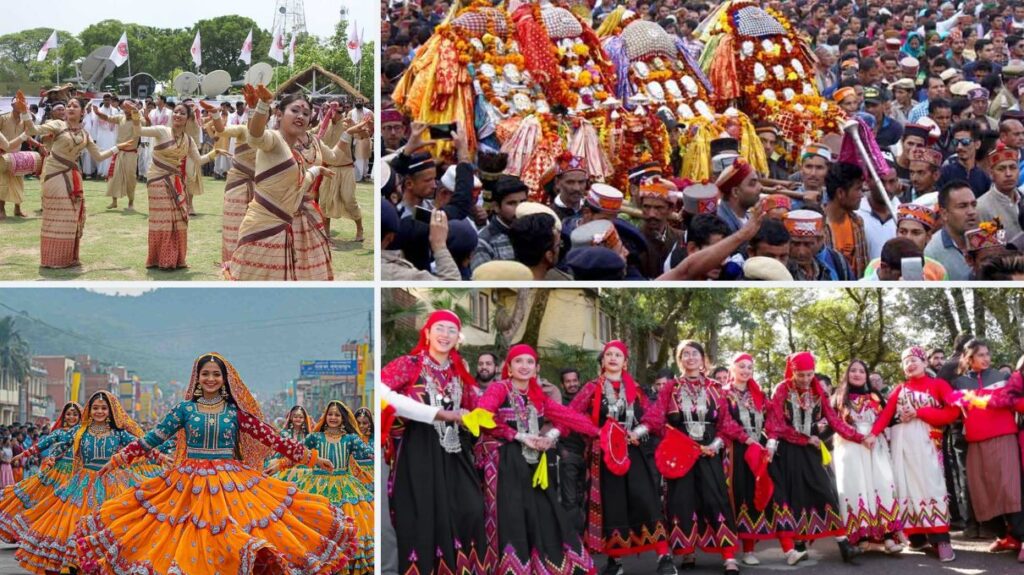
Wildlife and Natural Reserves
Himachal Pradesh is home to several national parks and wildlife sanctuaries that protect its rich biodiversity, making it an ideal destination for wildlife tourism. Notable wildlife reserves include:
- Great Himalayan National Park (GHNP): A UNESCO World Heritage Site located in Kullu, the GHNP spans over 620 km² and is home to diverse species like the snow leopard, Himalayan black bear, and the Western tragopan bird.
- Gobind Sagar Sanctuary: Situated in Bilaspur, this sanctuary is known for its diverse flora and fauna, including the giant flying squirrel and the Indian porcupine.
- Naina Devi Sanctuary: A reserve in the Una district, home to species like the Himalayan brown bear and a wide variety of birds.
- Narkanda: A small town located at an altitude of 8,850 feet, known for its apple orchards, scenic beauty, and proximity to the Himalayan National Park.
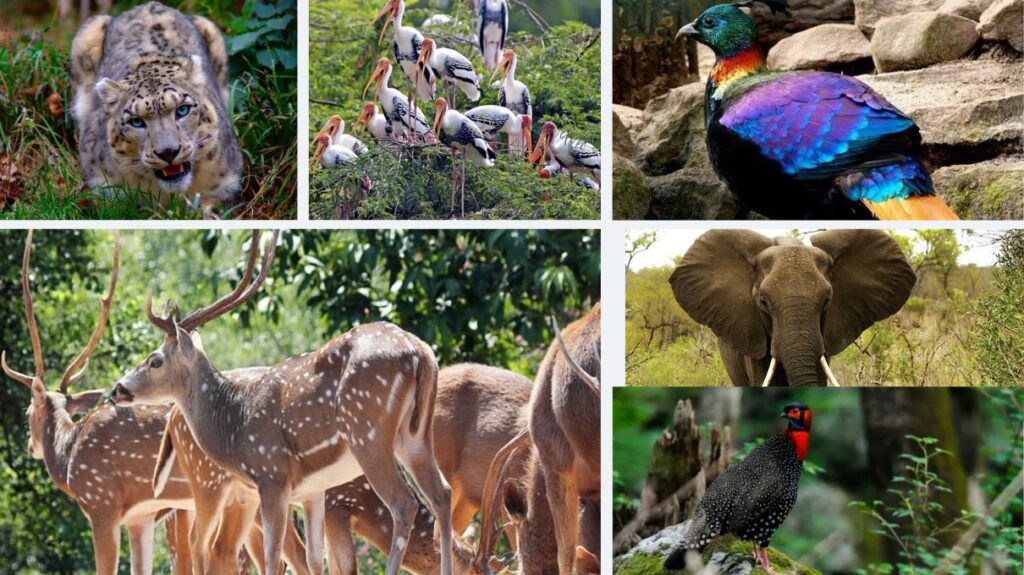
Transport in Himachal Pradesh
Due to its challenging mountainous terrain, transportation in Himachal Pradesh relies heavily on road networks and regional airports. The state is well-connected by air, rail, and road, though the accessibility of some remote areas may be limited by seasonal weather conditions, including snow and landslides. Let’s explore the key aspects of transportation in Himachal Pradesh:
Air Transport
Himachal Pradesh is served by three domestic airports, providing air connectivity to major cities like New Delhi and Chandigarh. These airports cater primarily to domestic tourists visiting the hill stations and other parts of the state:
- Kullu–Manali Airport (Bhuntar Airport): Located approximately 10 kilometers from the town of Kullu, this airport serves the popular tourist destinations of Kullu and Manali. It has regular flights connecting Kullu with New Delhi.
- Kangra Airport (Gaggal Airport): Situated about 15 kilometers from Dharamshala, the airport is well-connected with major cities like New Delhi. The airport serves as a gateway to Dharamshala and the scenic Kangra Valley.
- Shimla Airport (Jubbarhatti Airport): Located about 22 kilometers west of Shimla, the capital city of Himachal Pradesh, this airport connects Shimla with Delhi, facilitating the arrival of tourists to the city and its surrounding regions.
Railways
Himachal Pradesh has both narrow-gauge and broad-gauge railway lines, although the railway network is relatively limited compared to other parts of India. The state’s railway system is not only an important mode of transport but also a popular tourist attraction due to its scenic routes:
- Kalka-Shimla Railway: This UNESCO World Heritage Site is one of the most famous narrow-gauge railways in India. It connects Kalka in Haryana to Shimla and covers a distance of about 96 kilometers (60 miles), passing through tunnels and bridges with stunning views of the surrounding hills and valleys. The railway is known for its historic significance and scenic journey, attracting tourists from all over the world.
- Kangra Valley Railway: Another narrow-gauge line that connects Pathankot with Jogindernagar, this railway passes through the picturesque Kangra Valley. The 164-kilometer-long route offers a unique way to explore the natural beauty of the region.
- Broad-Gauge Lines: The state has one broad-gauge line that connects Amb Andaura to Nangal Dam in Punjab, passing through Una Himachal railway station. This electrified track serves as the primary broad-gauge route in the state.
- Future Railway Projects: Several railway projects are under construction or planned to improve connectivity in the state, including:
- Una Himachal–Hamirpur Rail Project via Dhundla
- Bhanupali (Punjab)–Bilaspur line
- Chandigarh–Baddi Line
Road Transport
Given Himachal Pradesh’s hilly terrain, road transport plays a vital role in the state’s connectivity. The road network in Himachal Pradesh is extensive and connects various towns, villages, and cities, although certain routes may remain inaccessible during the winter and monsoon seasons due to snowfall and landslides.
- National Highways and State Highways: The state has a road network of 28,208 kilometers (17,528 miles), including eight National Highways (NH) that cover 1,234 kilometers (767 miles) and 19 State Highways totaling 1,625 kilometers (1,010 miles). These highways are crucial for connecting the different regions of the state with major cities and neighboring states.
- Himachal Road Transport Corporation (HRTC): The state-owned transport corporation operates a fleet of over 3,100 buses, connecting important towns and cities within Himachal Pradesh, as well as interstate routes to cities like Delhi, Chandigarh, and others. HRTC buses are a common and affordable mode of transport for locals and tourists alike.
- Private Bus Operators: In addition to HRTC, around 5,000 private buses operate across the state, ensuring connectivity to more remote areas and offering alternatives to government-run services.
- Seasonal Challenges: Due to the state’s mountainous terrain, many roads are closed during the winter months due to snow and landslides. During the monsoon season, landslides also pose a significant risk to the road network, leading to temporary road blockages and delays.
Demographics of Himachal Pradesh
Himachal Pradesh, a northern state in India, boasts a rich and diverse demographic profile influenced by its unique geography, cultural heritage, and socio-economic conditions. The state’s population has been steadily growing over the years, and it is home to a variety of ethnic groups, languages, and religions. Below is a comprehensive overview of Himachal Pradesh’s demographic data, based on the Census of India 2011 and other key statistics.
Population Growth
Himachal Pradesh has experienced consistent population growth over the last century. From a population of just 1.92 million in 1901, the state saw its population rise to 6.86 million by 2011. The growth rate has varied over the decades, with a notable increase of 12.81% between 2001 and 2011.
| Year | Population | Growth Rate (%) |
|---|---|---|
| 1901 | 1,920,294 | — |
| 1911 | 1,896,944 | -1.2% |
| 1921 | 1,928,206 | +1.6% |
| 1931 | 2,029,113 | +5.2% |
| 1941 | 2,263,245 | +11.5% |
| 1951 | 2,385,981 | +5.4% |
| 1961 | 2,812,463 | +17.9% |
| 1971 | 3,460,434 | +23.0% |
| 1981 | 4,280,818 | +23.7% |
| 1991 | 5,170,877 | +20.8% |
| 2001 | 6,077,900 | +17.5% |
| 2011 | 6,864,602 | +12.9% |
As of 2011, the state’s population consisted of 3,481,873 males and 3,382,729 females. The sex ratio stood at 972 females for every 1,000 males, showing an improvement from 968 in 2001.
Scheduled Castes and Scheduled Tribes
- Scheduled Castes (SCs) make up 25.19% of the state’s population.
- Scheduled Tribes (STs) constitute 5.71% of the population.
The state’s child sex ratio also showed a positive trend, improving from 896 females per 1,000 males in 2001 to 909 in 2011, reflecting progress toward gender equity.
Literacy Rate
Himachal Pradesh has made tremendous strides in education, significantly boosting its literacy rate over the past few decades. The literacy rate nearly doubled, reflecting both government efforts and community engagement in education.
| Year | Literacy Rate (%) |
|---|---|
| 1971 | 31.96% |
| 1981 | 42.48% |
| 1991 | 63.86% |
| 2001 | 76.48% |
| 2011 | 83.78% |
In 2011, Himachal Pradesh’s literacy rate stood at an impressive 83.78%, making it one of the most literate states in India. The female literacy rate also showed notable improvement, contributing to the state’s overall progress in education.
Life Expectancy and Health Indicators
Himachal Pradesh has experienced significant improvements in health and life expectancy over the years. From a life expectancy of just 52.6 years in 1970-75, the figure rose to 72.0 years between 2011-2015, which is notably higher than the national average of 68.3 years.
Key health indicators include:
- Infant Mortality Rate (IMR): The IMR dropped to 40 per 1,000 live births in 2010, a marked decline from previous decades.
- Crude Birth Rate (CBR): The CBR has also decreased from 37.3 per 1,000 people in 1971 to 16.9 in 2010, showing improvements in family planning and healthcare.
Cultural and Linguistic Diversity
Himachal Pradesh is home to a variety of languages and cultures, which adds to the richness of its heritage. The state’s linguistic landscape is marked by several regional languages and dialects, with Pahadi languages (a group of Western Pahari languages) being the most widely spoken.
- Commonly Spoken Languages: Kangri, Mandeali, Punjabi, Kullu.
- Official Language: Hindi is the official language, widely spoken across the state, while Sanskrit is also recognized as an official language, though it is used more symbolically.
- Other Languages: Nepali (1.3%), Punjabi (4.4%), and Tibetan languages are spoken by the local Buddhist population, particularly in Lahaul and Spiti.
Religious Composition
Himachal Pradesh has a predominantly Hindu population, with 95.17% of people identifying as Hindus. The state is renowned for its strong Shaivism and Shaktism traditions, which are reflected in its many temples and religious festivals.
Other religious communities include:
- Islam (2.18%) – Predominantly found in Sirmaur, Chamba, and Solan districts.
- Sikhism (1.16%) and Buddhism (1.15%) – Buddhists are mostly concentrated in the Lahaul-Spiti and Kinnaur regions.
- Christianity (0.18%) and Jainism (0.03%) – Both are small minority religions in the state.
Major Castes and Communities
Himachal Pradesh’s social structure is shaped by a variety of caste groups:
- Brahmins, Rajputs, and Kanets are considered the higher castes in the region.
- The Koli community is the largest caste cluster, accounting for about 30% of the state’s population. Other important communities in Himachal include Kulindas, Girths, Raos, Rathis, and Chamars.
District-wise Population Distribution
The population in Himachal Pradesh is unevenly distributed across its 12 districts. Some districts are more densely populated than others, with Kangra being the most populous.
- Kangra District: The largest district with 1,507,223 people, making up 21.98% of the state’s total population.
- Mandi: With a population of 999,518.
- Shimla: Home to 813,384 people.
- Solan: With a population of 576,670.
On the other hand, the more sparsely populated districts are:
- Lahaul-Spiti: With only 31,528 residents.
- Kinnaur: Home to 84,298 people.
Education in Himachal Pradesh
Himachal Pradesh has made remarkable progress in education since India’s independence, transforming from a state with one of the lowest literacy rates to one of the most literate regions in the country. In 1947, the literacy rate in Himachal Pradesh stood at a mere 8%, but through sustained government efforts and social initiatives, the state’s literacy rate rose to 82.8% by the 2011 Census. This dramatic improvement reflects a concerted push to expand educational access, quality, and gender parity.
Expansion of Education Infrastructure
Himachal Pradesh has developed a robust educational infrastructure that ensures education is accessible across both urban and rural areas. The state boasts a large network of schools at various levels:
- Over 10,000 primary schools,
- Around 1,000 secondary schools, and
- More than 1,300 high schools.
This extensive network plays a pivotal role in providing educational opportunities to children, regardless of their geographical location. Additionally, Himachal Pradesh became the first state in India to make elementary education compulsory, well ahead of the nationwide implementation of the Right to Education Act. As a result, the state has achieved near-universal enrollment in primary education, with girls’ enrollment rates being particularly high.
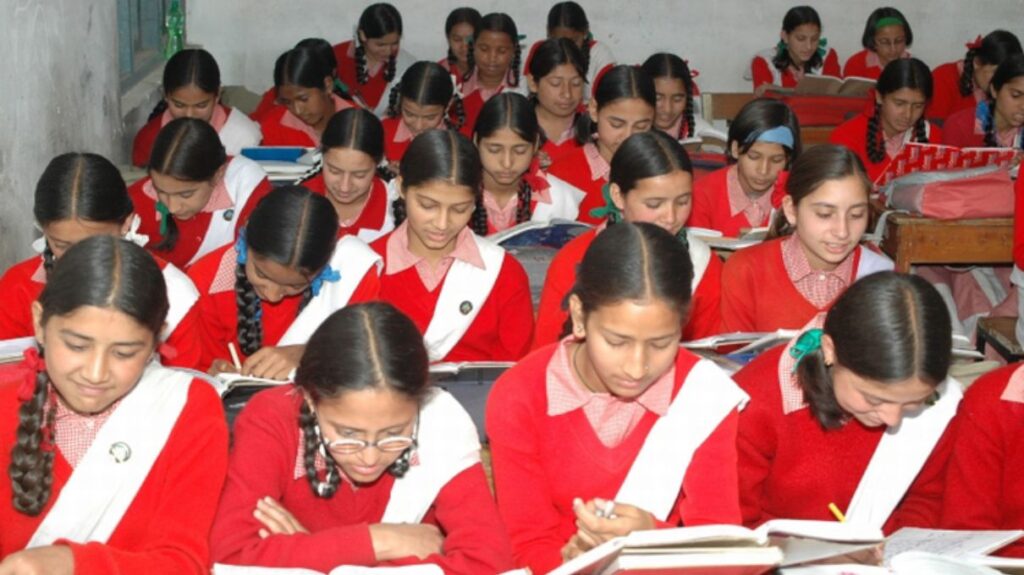
A key factor behind this success is the focus on gender parity in education. As of the 2011 Census, the literacy rate for females in Himachal Pradesh stood at 76%, which is significantly higher than the national average for women. The state’s commitment to promoting education for girls is evident in its near-universal school enrollment for girls at the primary level.
Government Initiatives to Improve Education
The government of Himachal Pradesh has been proactive in addressing educational challenges, particularly in improving infrastructure and teacher quality. Initial efforts focused on increasing the number of schools and teachers, but from the Seventh Five-Year Plan onwards, the focus shifted to enhancing the quality of education and modernizing the curriculum.
Several key initiatives have played a crucial role in this transformation:
- Vidya Upasak Yojna (2001): This scheme aimed to improve the teacher-student ratio in primary schools by appointing over 1,000 teacher aides. This initiative helped address staffing shortages and provided additional support for students, especially in rural areas.
- Sarva Shiksha Abhiyan: This nationwide program aimed at providing universal elementary education saw substantial success in Himachal Pradesh, improving school participation rates and encouraging local communities to take an active role in school management.
- Rashtriya Madhyamik Shiksha Abhiyan (2009): This program focused on improving secondary education, particularly in rural and underserved areas. The state government also took steps to integrate digital education to enhance learning outcomes.
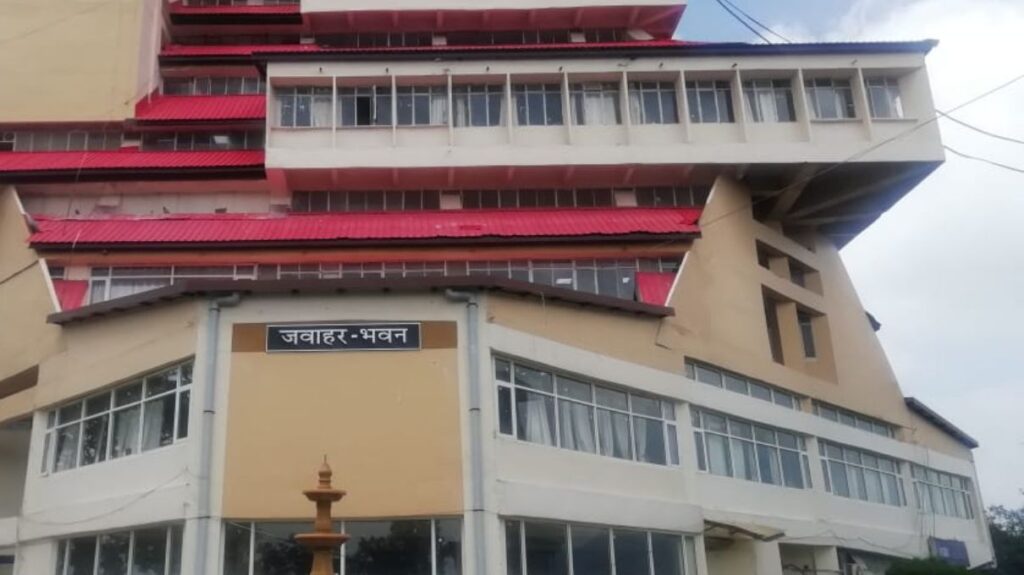
Higher Education in Himachal Pradesh
The state has also invested in higher education, with several prestigious institutions that attract students from all over the country. These include:
- Indian Institute of Technology (IIT) Mandi: One of the premier engineering institutions in India, offering world-class education in technology and innovation.
- Indian Institute of Management (IIM) Sirmaur: A leading business school offering advanced management programs.
- National Institute of Technology (NIT) Hamirpur: A top-ranking institute for technical education in the region.
- Himachal Pradesh University, Shimla: A comprehensive university offering a wide range of undergraduate and postgraduate courses.
- Indira Gandhi Medical College and Hospital, Shimla: One of the foremost medical colleges in the state, producing quality healthcare professionals.
Himachal Pradesh is also home to specialized institutions such as:
- CSK Himachal Pradesh Krishi Vishwavidyalya: A globally renowned agricultural university in Palampur, focusing on hill agriculture.
- Dr. Yashwant Singh Parmar University of Horticulture and Forestry: Unique for its focus on horticulture, forestry, and allied fields, it is an important research and educational hub for students in these sectors.
These institutions have significantly enhanced the state’s academic reputation and are key players in the development of skilled professionals across various fields.
Gender Parity in Education
One of the standout features of Himachal Pradesh’s education system is its gender parity. With a female literacy rate of 76.6% compared to male literacy at 90.8%, the state is a leader in promoting women’s education. Government initiatives have focused not only on enrolling girls in schools but also on ensuring their retention and progression through education.
Policies such as free textbooks for girls, scholarships, and stipends have encouraged girls to pursue education at all levels. The result is a significant reduction in gender-based disparities in literacy and educational attainment. Additionally, the state’s commitment to gender equality is reflected in the near-universal school enrollment for girls, which is a significant achievement in a state where many areas are geographically isolated.
Challenges and Future Goals
While Himachal Pradesh has made remarkable strides, challenges remain, especially in the more remote and hilly areas. The state’s terrain and geography make it difficult to provide education in certain regions, which can create logistical challenges in terms of infrastructure and teacher availability.
To overcome these barriers, the state government has focused on:
- Expanding rural educational infrastructure,
- Increasing access to digital education resources, and
- Providing distance education for students in far-flung areas.
Furthermore, the government is concentrating efforts on enhancing the quality of secondary and tertiary education. There is a growing emphasis on skill development, vocational training, and entrepreneurship programs to ensure students are equipped for the job market and can contribute to the state’s economic growth.
Key Educational Institutions in Himachal Pradesh
The state’s educational infrastructure is complemented by several world-class institutions that offer a range of courses and research opportunities. Some of the significant higher educational institutions include:
- Indian Institute of Technology (IIT) Mandi
- Indian Institute of Management (IIM) Sirmaur
- National Institute of Technology (NIT) Hamirpur
- Himachal Pradesh University, Shimla
- Indira Gandhi Medical College and Hospital, Shimla
- Dr. Rajendra Prasad Government Medical College, Kangra
These institutions not only cater to the local student population but also attract students from across India, further enhancing Himachal Pradesh’s status as a hub for higher education.
State Profile of Himachal Pradesh
Himachal Pradesh, located in the northern part of India, is known for its picturesque landscapes, rich cultural heritage, and growing economy. The state’s geographical and demographic features, coupled with its commitment to education and infrastructure development, make it a unique and important region in the country. Below is a detailed profile of Himachal Pradesh based on data provided by the Department of Information and Public Relations.
Geographical Area and Population
- Total Area: 55,673 km²
- Total Population: 7,781,244
- Male Population: 3,946,646
- Female Population: 3,834,598
- Population Density: 123 persons per square kilometer
- Sex Ratio: 972 females for every 1,000 males
- Rural Population: 6,176,050
- Urban Population: 688,552
The state’s relatively low population density indicates its hilly terrain and vast stretches of forests, which makes Himachal a predominantly rural state. However, it has seen gradual urbanization in recent years, especially in towns and cities like Shimla and Dharamsala.
Demographics and Social Structure
- Scheduled Caste Population: 1,729,252
- Scheduled Tribe Population: 392,126
- Literacy Rate: 83.78%
- Male Literacy: 90.83%
- Female Literacy: 76.60%
Himachal Pradesh has made significant progress in improving literacy rates, especially among females, despite the challenges posed by its mountainous terrain. The state’s government has prioritized education, which is reflected in the high literacy rates.
Governance and Administrative Divisions
- Capitals: 2 (Shimla and Dharamsala)
- Districts: 12
- Sub-divisions: 71
- Tehsils: 169
- Sub-tehsils: 38
- Developmental Blocks: 78
- Towns: 59
- Panchayats: 3,243
- Panchayat Samitis: 77
- Zila Parishads: 12
- Urban Local Bodies: 59
- Nagar Nigams: 2
- Nagar Parishads: 25
- Nagar Panchayats: 23
- Census Villages: 20,690
- Inhabited Villages: 17,882
The administrative structure of Himachal Pradesh is well-organized to facilitate decentralized governance, with local bodies playing a critical role in managing day-to-day affairs and promoting rural development.
Infrastructure and Health
- Health Institutions: 3,866
- Educational Institutions: 17,000
- Motorable Roads: 33,722 km
- National Highways: 8
Himachal Pradesh has a well-established infrastructure, particularly in the transportation and healthcare sectors. The state’s extensive road network connects even remote areas, making it accessible to both residents and tourists. The growth in health institutions also reflects the state government’s commitment to improving healthcare services.
Economic Profile
- Hydroelectric Potential: 23,000.43 MW (across five river basins: Yamuna, Satluj, Beas, Ravi, Chenab, and Himurja)
- Potential Harnessed: 10,264 MW
Himachal Pradesh is rich in water resources and has significant hydroelectric potential. The state’s hydroelectric power generation capacity contributes substantially to India’s overall power supply, making Himachal an important player in the renewable energy sector.
- Food Grain Production: 15.28 lakh MT
- Vegetable Production: 18.67 lakh MT
- Fruit Production: 1,027,000 tonnes
The state’s agriculture sector is diverse, with a focus on both food grain and fruit production. Apples, in particular, are a significant cash crop in Himachal Pradesh, with the region being one of the largest producers in India.
- Per Capita Income: ₹2,01,854 (2021–22)
Himachal Pradesh has a relatively high per capita income compared to many other states, a result of its growing tourism, agriculture, and industrial sectors.
Social Welfare and Employment
- Social Security Pensions: 237,250 persons, with an annual expenditure of over ₹600 million
- Investment in Industrial Areas: ₹273.80 billion, with over 337,391 employment opportunities
- Employment Generated in Government Sector: 2,17,142
The government has invested significantly in social security and employment generation, with a focus on supporting both the elderly population through pensions and creating new job opportunities in various sectors.

